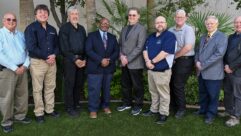
Orban announced the Optimod XPN-Enterprise ecosystem.
The company describes it as a customizable, Linux-based processing platform with capabilities for centralized contexts, particularly broadcast groups that run multiple stations or clusters and/or streaming services.
“It provides Orban’s proprietary OptiCloud processing for up to eight FM and eight HD/DAB+/Streaming processing channels in a 1 RU package and supports AES-67/SMPTE-2110 protocols using an enterprise-class SoftGear server and the appropriate Optimod XPN-Enterprise Nodes,” the company stated.
The XPN-Enterprise server is shipping, as is the XPN-Enterprise AES3 Input/Output Node. Orban said nodes to extend the available outputs and functionalities are coming including DMPX, Kantar and Nielsen watermarking and Orban uMPX.
“Broadcasters worldwide are realizing the benefits of moving operations to centralized — and ideally, virtualized — environments. Many of these customers have high-density needs, with many signals that need to be managed,” it quoted Orban President David Day in the announcement.
Content to be OptiCloud processed is brought to one location using AES3, AES-67, SMPTE-2110-30, Dante or Livewire+, and creates the necessary outputs (FM composite, DMPX, uMPX and DAB+HD) using the appropriate Orban XPN-Enterprise Nodes for distribution to each transmitter site, the company said.
The server also handles processed channels for streaming, sending those outputs to the appropriate streaming devices.
“Each signal coming into the Optimod XPN-Enterprise server can be individually processed, with Orban’s OptiCloud providing precision tailoring of each station’s broadcast or stream to meet the requirements of the audience and delivery method,” it continued.
Features include factory presets for various formats, and “Less-More” controls to simplify “dialing in” a desired sound by combining multiple processing parameters.
Day also highlighted the company’s “Last Mile” solutions including XPN-Enterprise input and output nodes and low-bandwidth solutions.
“This ‘Last Mile’ service is especially important for stations whose transmitter sites may be in locations with less-than-ideal internet access. We make it possible to manage our processing remotely and feed that signal to a site on lines as slow as 500 kbps, with high-quality results. And many nodes are ‘Power over Ethernet’ (PoE) capable, further simplifying installation.”











